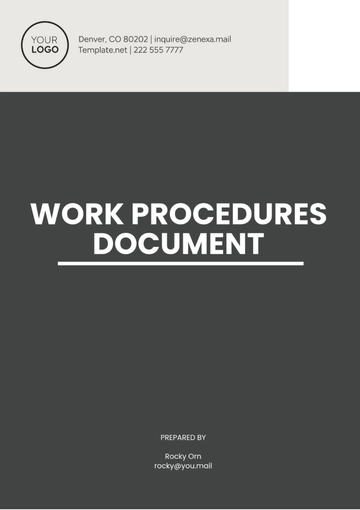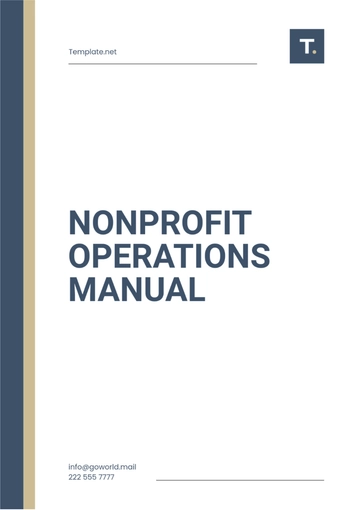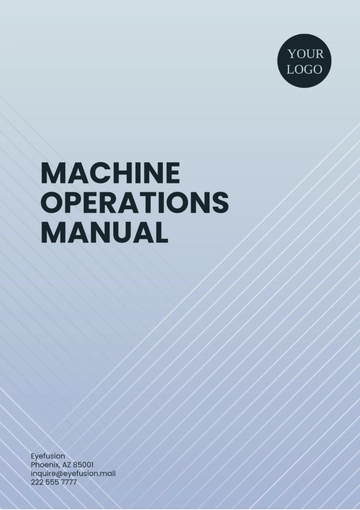Free Restaurant Beverage Analysis Manual

I. Introduction
In the competitive restaurant industry, effective beverage analysis is crucial for success. [Your Company Name], a renowned restaurant business, understands the importance of meticulous beverage management. This manual serves as a comprehensive guide to understanding and implementing best practices in beverage analysis, ensuring that [Your Company Name] remains at the forefront of the industry.
II. Beverage Inventory Management
Accurate inventory management is vital for controlling costs and ensuring optimal stock levels. [Your Company Name] employs the following procedures:
Regular Inventory Audits: Conducted weekly to track usage and identify discrepancies. These audits involve physically counting all beverage stock and comparing it to the recorded inventory levels.
Inventory Tracking Software: Utilized to streamline the process and generate reports. This software allows [Your Company Name] to track inventory levels in real-time, facilitating better decision-making regarding stock replenishment.
Stock Replenishment: Based on par levels and sales forecasts to prevent stockouts. By setting par levels (minimum stock levels), [Your Company Name] ensures that they always have enough stock on hand to meet customer demand without overstocking.
Supplier Relationships: Maintained to negotiate favorable terms and ensure timely deliveries. [Your Company Name] works closely with its suppliers to negotiate prices, terms, and delivery schedules, optimizing their inventory management.
III. Beverage Cost Control
Understanding and controlling beverage costs are fundamental to profitability. [Your Company Name] adopts the following strategies:
Beverage Cost Calculation: Calculated as Cost of Goods Sold (COGS) divided by Total Sales. COGS includes the cost of purchasing beverages, as well as any additional costs such as labor and overhead.
Pricing Strategies: Utilizing cost-plus pricing to ensure a desirable profit margin. Cost-plus pricing involves adding a markup to the cost price of beverages to achieve a desired profit margin.
Portion Control: Implementing standard pour sizes to minimize overpouring. By standardizing pour sizes, [Your Company Name] can control costs and reduce waste.
Menu Engineering: Analyzing menu items to maximize profitability and popularity. [Your Company Name] regularly reviews its menu to identify high-profit items and promote them to customers.
IV. Beverage Menu Development
A well-crafted beverage menu can enhance customer experience and boost sales. [Your Company Name] focuses on the following aspects:
Market Trends Analysis: Monitoring industry trends to incorporate popular items. By staying up-to-date with the latest trends, [Your Company Name] can offer beverages that appeal to its target market.
Diverse Selection: Offering a variety of beverages to cater to different preferences. [Your Company Name] ensures that its menu includes a wide range of options, including alcoholic and non-alcoholic beverages, to appeal to all customers.
Pricing Optimization: Setting prices based on cost, competition, and perceived value. [Your Company Name] carefully considers the cost of beverages, as well as the prices charged by competitors, when setting its prices.
Menu Presentation: Using descriptive language and appealing visuals to entice customers. [Your Company Name] designs its menu to be visually appealing, with high-quality images and engaging descriptions that encourage customers to try new beverages.
V. Beverage Quality Control
Maintaining consistent quality is essential for customer satisfaction. [Your Company Name] implements the following measures:
Supplier Selection: [Your Company Name] meticulously chooses to partner with suppliers who are well-regarded for their ability to provide ingredients of the highest quality, ensuring that all products meet our rigorous standards.
Storage Conditions: To ensure the maintenance of freshness, it is essential to store beverages under suitable conditions. [Your Company Name] conscientiously stores its beverages in an environment that is cool and dry, explicitly positioned away from any direct sunlight and sources of heat, thereby guaranteeing their continued freshness.
Staff Training: [Your Company Name] is committed to delivering excellence in every cup. To achieve this, we emphasize the continuous education of our staff members, providing them with extensive and regular training sessions. These sessions cover the proper techniques for handling and serving beverages, ensuring that each customer enjoys a consistently high-quality product every time they visit.
Customer Feedback: [Your Company Name] actively encourages its customers to provide feedback on its range of beverages. By soliciting this feedback, the company is dedicated to utilizing the insights gathered to enhance the quality and appeal of its products and services. Through this ongoing process, [Your Company Name] commits to continually improving in response to customer input, aiming to deliver superior customer satisfaction.
By adhering to these practices, [Your Company Name] ensures that its beverage offerings are not only profitable but also meet the high standards expected by its customers.
VI. Beverage Ordering and Receiving
Efficient ordering and receiving processes are essential for maintaining adequate stock levels and ensuring the freshness of beverages. [Your Company Name] follows these procedures:
Ordering Procedures: Orders are typically placed based on par levels, historical sales data, and upcoming promotions. The beverage manager is responsible for reviewing stock levels and placing orders with approved suppliers.
Receiving and Inspecting Deliveries: Upon delivery, all beverage items are checked for accuracy and quality. This includes verifying quantities, checking for damaged items, and ensuring that all products meet quality standards.
Handling Discrepancies: Any discrepancies in the order are immediately reported to the supplier for resolution. This may include missing items, incorrect quantities, or damaged products.
VII. Beverage Storage and Rotation
Proper storage and rotation practices are crucial for maintaining the quality and freshness of beverages. [Your Company Name] follows these guidelines:
Storage Conditions: Beverages are kept in a specifically designated area, which is maintained to be clean, and dry, and possesses adequate ventilation to ensure their quality and safety. Furthermore, to prevent any incidents of theft, alcoholic beverages are stored in a secure manner.
FIFO (First In, First Out) Rotation Method: Beverages in inventory are managed by implementing the First-In, First-Out (FIFO) principle, which ensures that items that were stocked earlier are used before those that were stocked later. This systematic rotation of stock helps prevent any spoilage and reduces waste by ensuring older products are consumed first.
Preventing Spoilage and Waste: Regular inventory audits are routinely carried out with the objective of identifying stock that is either moving slowly or has already expired. To reduce waste, strategies are implemented including the initiation of special promotions on items that are approaching their expiration dates.
VIII. Beverage Service Standards
Exceptional service is a hallmark of [Your Company Name]'s brand. The following standards are upheld:
Best Practices for Beverage Service: Staff are trained to greet guests promptly, offer recommendations, and provide attentive service throughout the meal.
Training Staff on Beverage Service: The staff members receive extensive and thorough training that encompasses a comprehensive understanding of the beverage offerings available, which includes detailed knowledge of wines and cocktails, in addition to being educated in the correct techniques for serving these beverages effectively and professionally.
Handling Customer Inquiries and Complaints: Staff members undergo comprehensive training designed to equip them with the skills and knowledge necessary to professionally and efficiently address and resolve customer inquiries and complaints, thereby guaranteeing that every customer interaction results in a positive and satisfying customer experience.
IX. Beverage Promotion and Marketing
Strategy | Description |
|---|---|
Happy Hour Specials | Offer discounted prices on select beverages during off-peak hours to attract customers and increase sales. |
Themed Drink Nights | Host themed nights, such as "Taco Tuesday" or "Wine Wednesday," featuring special beverage offerings that align with the theme to create a unique and enjoyable experience for customers. |
Limited-Time Offers | Introduce limited-time beverage offerings, such as seasonal cocktails or exclusive imports, to create a sense of urgency and encourage customers to try new items. |
Collaborations with Suppliers | Partner with beverage suppliers and brands to create exclusive promotions, events, or tastings, providing customers with unique and exciting experiences while driving sales. |
Analyzing Promotion Effectiveness | Regularly analyze sales data to evaluate the success of promotions and marketing efforts, identifying which strategies are most effective and informing future promotional campaigns. |
X. Beverage Analysis Tools and Software
Tool/Software | Description |
|---|---|
Inventory Management Software | Tracks inventory levels, generates reports, and forecasts future inventory needs, helping optimize stock levels and reduce the risk of stockouts. |
Point-of-Sale (POS) System | Tracks sales data, including which beverages are selling well and which are not, aiding in decision-making regarding menu offerings and promotions. |
Customer Relationship Management (CRM) Software | Tracks customer preferences and behavior, allowing for targeted marketing campaigns and personalized promotions. |
XI. Future Directions and Continuous Improvement
In looking ahead, [Your Company Name] remains committed to ongoing improvement and innovation in its beverage analysis practices. This commitment includes:
Technology Integration: Exploring advanced technologies, such as AI-driven analytics, to enhance inventory management and forecasting accuracy, leading to more informed decision-making.
Sustainability Initiatives: Implementing environmentally friendly practices, such as sourcing local and organic ingredients, to align with consumer preferences and reduce environmental impact.
Menu Diversification: Continuously updating and diversifying the beverage menu to cater to changing consumer tastes and preferences, ensuring a dynamic and appealing selection.
Staff Training and Development: Investing in ongoing training and development programs for staff to enhance their knowledge and skills in beverage service and analysis.
Customer Engagement: Increasing customer engagement through interactive promotions, events, and social media campaigns, fostering a loyal customer base and driving repeat business.
By embracing these strategies, [Your Company Name] aims to stay at the forefront of the industry, delivering exceptional beverage offerings and experiences to its customers while maintaining operational excellence and profitability.
- 100% Customizable, free editor
- Access 1 Million+ Templates, photo’s & graphics
- Download or share as a template
- Click and replace photos, graphics, text, backgrounds
- Resize, crop, AI write & more
- Access advanced editor
Optimize your beverage management with Template.net’s customizable Restaurant Beverage Analysis Manual Template. Easily editable using our AI Editor Tool, this template provides a comprehensive framework for analyzing beverage performance. Perfect for enhancing your restaurant’s operational efficiency and profitability, this user-friendly template ensures your beverage analysis is thorough and professional.





























